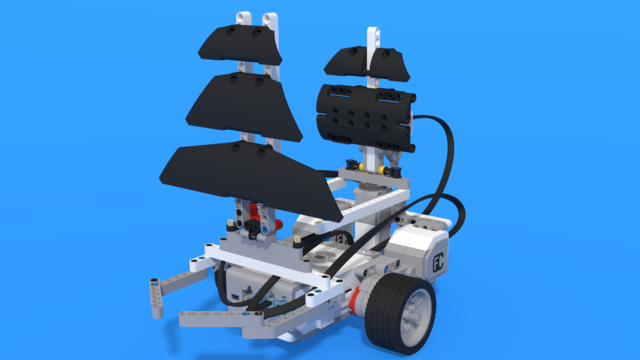Use any corner of the room as a starting position of the robots. The two perpendicular walls will be the feeding spots. Parallel to one of the walls, about two meters ahead, stick some tape which will mark the entrance to the coral reef. Turn a box for LEGO parts upside down and use it as a rock. You can see the field below:

To access the full video please subscribe to FLLCasts.com
- #1120
- 14 Jan 2019

Courses and lessons with this Tutorial
This Tutorial is used in the following courses and lessons

Level D1. "Animals". Robotics with LEGO
This is the seventh level of the Robotics with LEGO curriculum for students in third or fourth grade.
In this level students focus on the rotational sensor that is part of every motor in the robotics set.
Robot constructions imitate animals and their behavior. Students create programs that check whether the robot's claws or pecks have successfully caught an object. That sensor in the motors allows the robots to go back in their lairs even after the use of unlimited movement.
- 23
- 0:00
- 102

Lesson 2 - Fish
Introduction
In this lesson we are going to build a fish robot.
Have you ever been fishing? Have you seen live fish? Where?

Just like the fish on the picture, today’s robot lives in a coral reef. As many other fish live safely in the coral reef, just like ours, there is not much food left there. Therefore, our task today will be to help the fish robot search the region around its home and find some food.
- 3
- 4
- 3
- 3d_rotation 1

Robotics with LEGO - Level 2.5 - Maritime Journey
The fourth level of the Robotics with LEGO curriculum for students from fifth to twelfth grades.
In this level students focus on the rotational sensor that is part of every motor in the robotics set. Students also learn to use the fourth sensor in the robotics set - the gyro sensor.
First few robot constructions imitate sea-animals and their behavior. Students create programs that check whether the robot's claws or pecks have successfully caught an object. That sensor in the motors allows the robots to go back in their lairs even after the use of unlimited movement. The rest of the robots are modeled after boats, yachts, and ships. With the help of the gyro sensor, students can set a course for their robots to a given angle and can detect deviations from the course. In open seas, there may be sea-monsters and the robots are being programmed to detect a sudden change in acceleration with the help of the said sensor.
- 42
- 3:52
- 133
